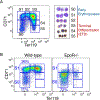Pas de deux: the coordinated coupling of erythroid differentiation with the cell cycle
- PMID: 38415760
- PMCID: PMC11032070
- DOI: 10.1097/MOH.0000000000000811
Pas de deux: the coordinated coupling of erythroid differentiation with the cell cycle
Abstract
Purpose of review: Recent work reveals that cell cycle duration and structure are remodeled in lock-step with distinct stages of erythroid differentiation. These cell cycle features have regulatory roles in differentiation, beyond the generic function of increasing cell number.
Recent findings: Developmental progression through the early erythroid progenitor stage (known as colony-forming-erythroid, or 'CFU-e') is characterized by gradual shortening of G1 phase of the cycle. This process culminates in a key transcriptional switch to erythroid terminal differentiation (ETD) that is synchronized with, and dependent on, S phase progression. Further, the CFU-e/ETD switch takes place during an unusually short S phase, part of an exceptionally short cell cycle that is characterized by globally fast replication fork speeds. Cell cycle and S phase speed can alter developmental events during erythroid differentiation, through pathways that are targeted by glucocorticoid and erythropoietin signaling during the erythroid stress response.
Summary: There is close inter-dependence between cell cycle structure and duration, S phase and replication fork speeds, and erythroid differentiation stage. Further, modulation of cell cycle structure and speed cycle impacts developmental progression and cell fate decisions during erythroid differentiation. These pathways may offer novel mechanistic insights and potential therapeutic targets.
Copyright © 2024 Wolters Kluwer Health, Inc. All rights reserved.
Figures




Similar articles
-
The role of specialized cell cycles during erythroid lineage development: insights from single-cell RNA sequencing.Int J Hematol. 2022 Aug;116(2):163-173. doi: 10.1007/s12185-022-03406-9. Epub 2022 Jun 27. Int J Hematol. 2022. PMID: 35759181 Free PMC article. Review.
-
Short-Term Memory Impairment.2024 Jun 8. In: StatPearls [Internet]. Treasure Island (FL): StatPearls Publishing; 2025 Jan–. 2024 Jun 8. In: StatPearls [Internet]. Treasure Island (FL): StatPearls Publishing; 2025 Jan–. PMID: 31424720 Free Books & Documents.
-
The Black Book of Psychotropic Dosing and Monitoring.Psychopharmacol Bull. 2024 Jul 8;54(3):8-59. Psychopharmacol Bull. 2024. PMID: 38993656 Free PMC article. Review.
-
The effect of stem-cell factor, interleukin-3 and erythropoietin on in vitro erythropoiesis in myelodysplastic syndromes.J Cancer Res Clin Oncol. 1995;121(6):338-42. doi: 10.1007/BF01225685. J Cancer Res Clin Oncol. 1995. PMID: 7797598 Free PMC article.
-
EORTC guidelines for the use of erythropoietic proteins in anaemic patients with cancer: 2006 update.Eur J Cancer. 2007 Jan;43(2):258-70. doi: 10.1016/j.ejca.2006.10.014. Epub 2006 Dec 19. Eur J Cancer. 2007. PMID: 17182241
Cited by
-
Inactive Parp2 causes Tp53-dependent lethal anemia by blocking replication-associated nick ligation in erythroblasts.Mol Cell. 2024 Oct 17;84(20):3916-3931.e7. doi: 10.1016/j.molcel.2024.09.020. Epub 2024 Oct 8. Mol Cell. 2024. PMID: 39383878
-
The glucocorticoid receptor elicited proliferative response in human erythropoiesis is BCL11A-dependent.Stem Cells. 2024 Nov 5;42(11):1006-1022. doi: 10.1093/stmcls/sxae049. Stem Cells. 2024. PMID: 39110040 Free PMC article.
References
-
- Hwang Y, Hidalgo D, Socolovsky M: The shifting shape and functional specializations of the cell cycle during lineage development. WIREs Mech Dis 2021, 13:e1504. - PMC - PubMed
-
This review article summarizes interactions between the cell cycle and differentiation programs in a number of mammalian lineages, with emphasis on the erythroid lineage
-
- Socolovsky M: The role of specialized cell cycles during erythroid lineage development: insights from single-cell RNA sequencing. Int J Hematol 2022, 116:163–173. - PubMed
-
- Zhang J, Socolovsky M, Gross AW, Lodish HF: Role of Ras signaling in erythroid differentiation of mouse fetal liver cells: functional analysis by a flow cytometry-based novel culture system. Blood 2003, 102:3938–3946. - PubMed
Publication types
MeSH terms
Grants and funding
LinkOut - more resources
Full Text Sources
Research Materials

